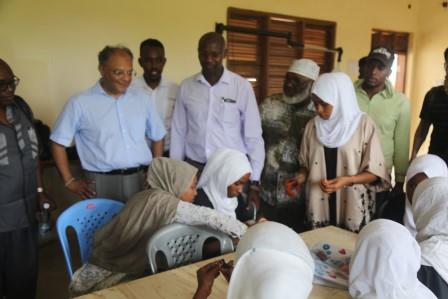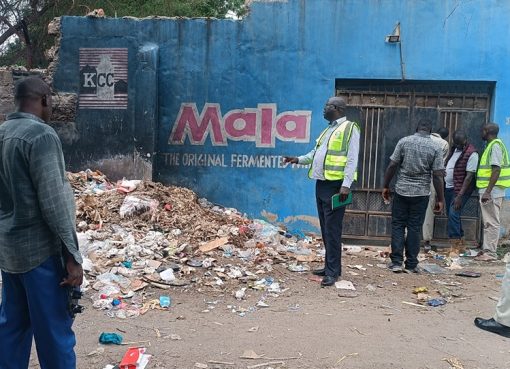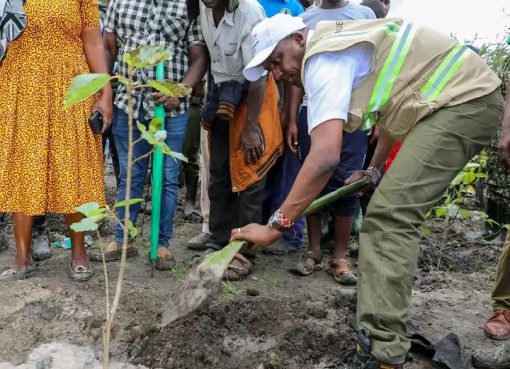With a 93 percent transition for pupils joining secondary schools in Lamu this year, the county looks set to beat its school transition blues due to a raft of measures and goodwill put in place by both the national and county government.
According to Lamu County Education Director Joshua Kaaga the 93 percent rate is a steep ascent from the a few years back when Lamu County could barely muster a 60 percent transition rate for pupils joining secondary school.

(from; Right to Left) Lamu County Commissioner Irungu Macharia flanked by Lamu County Education Chief Officer Mohammed Sagara and Colonel David Chesire during a tour inspection of Boni Schools in Lamu to ensure they re-open after five years of insurgency fears drove teachers away. The national government has improved security as well as advertised for teacher intern positions for schools in the area in a bid to ensure learning resumes and returns to normalcy.
“Lamu County is among the top five counties that has achieved more than 90 percent transition rate for children joining secondary school,” Kaaga states adding that less than 150 children have still not reported to secondary school.
“The key to achieving a 100 percent secondary school transition rate in Lamu, has largely been down to the national government’s approach of working with the chiefs to ensure that no child is left behind,” he said.
He further reveals that 2,307 students have so far been admitted to secondary school, in which he stated that the county government has gone as far as offering scholarships and bursaries for needy students in a bid by the county government to tackle low literacy levels.
The Lamu county government has set aside Sh 176 million for scholarships and bursaries for the 2019/2020 financial year.
All students who scored above 300 marks in their KCPE exams are eligible for scholarships down from the set 350 marks that the county government had set in the previous financial year.
All 646 KCPE students in Lamu who scored above 300 marks in the 2019 KCPE results will receive a four-year scholarship in the secondary schools that they joined.
The initiative is aided by the county’s increase in its bursary allocation from Sh 127 million in the previous financial year to Sh 176 million for 2019/2020 Financial Year, in a move that Lamu Governor, Fahim Twaha, has intimated will arrest high dropout rates, especially among girls.
“There is literally no excuse for any parent not to ensure that their children attend secondary school as things stand with the bursaries and scholarship programme that is ongoing under the current administration,” CEC in charge of education Paul Thairu states.
Currently, the county government is also fully sponsoring students transitioning into Technical Training Institutes (TVETs) within Lamu County.
“Lamu residents are free to join any TVET within Lamu, enroll for a course whether it is plumbing, welding, hairdressing, tourism and hospitality, electrical and wiring and the county government will fully sponsor them to gain skills in addition to a starter kit once they complete their studies,” Thairu reveals.
The county education executive further notes that education is among the three key sectors that Governor Twaha’s administration decided to focus on, in a bid to raise the county’s profile from a backwater fishing county to a bustling metropolis.
“If we, as county government, can get it right by budgeting our resources to ensure education, health, and job creation are achieved, we will be on track in ensuring that Lamu residents reap the fruits of devolution,” Governor Fahim Twaha stated in a previous interview.
Sentiments echoed by Lamu Education Chief Officer Mohammed Sagara who adds that there is need to invest more resources to improve education standards if the county is to catch up with the rest of the nation in terms of education.

Kenyatta Primary students during a school open day. Lamu presently has a 93 percent secondary school transition rate that has been facilitated by the national and county government efforts to improve education standards with increased investment and goodwill by all stakeholders.
“As a county we are playing catch up, and that is why it key that all stakeholders play their part in ensuring education standards improve in Lamu,” Sagara observes.
Lamu County Director Joshua Kaaga further opines that as much as a transition rate is important the key to improving education standards in Lamu lies in student retention.
“The national government through the county commissioner’s office has been very supportive in ensuring that no child drops out either due to early child marriages or schools being closed due to fear of Al-Shabaab attacks as has been case for the past five years in the Boni area,” Kaaga says.
He notes that the national government in January set about to reopen all the five schools that had been closed in the Boni area by increasing security in the area.
Children within the Boni area had been forced to take up schooling at Kiunga Day School or Mokowe Arid boarding school both of which pose logistical challenges for the children.
“The children should be able to go to a school that is near to where they live, not 80 kilometres as has been the case due to fear of Al-Shabaab attacks,” Kaaga adds.
The senior education officer notes that ensuring school retention for students in the Boni has been problematic in the past due to the insurgency factor that played a role in the high dropout rates.
“By reopening the schools in the Boni area, and posting teachers and teacher interns, national government providing resources, refurbishing the schools and assuring the teachers security, learning has been eased for students within the forest,” Kaaga states.
The teachers posted within the Boni stay with security personnel within their camps to ensure their security is guaranteed.
In Mararani area, the Boni locals have gone as far as to build for the head teacher a house in a bid to attract those willing to teach in the Boni area school.
Presently the national government through the Teachers Service Commission has advertised for teacher intern positions with a Sh 10,000 stipend for teachers who will be posted in the five schools.
“Another key area that we have tried to tackle is curbing early child marriages, which is especially rife in certain parts of Lamu,” Kaaga states.
Sentiments further echoed by Lamu County Commissioner Irungu Macharia, who states that there is a national directive to all chiefs to ensure that no child is forced into an early union.
“We have done county-wide barazas warning parents against marrying off their children, failure to comply by this directive, they risk being prosecuted,” Macharia states.
The directive already seems to gaining traction with communities such as the Orma where early marriages were rife discarding the practice in favour of their girls getting education.
“We realise that unless we support our children to complete their schools, we will be awkwardly placed once developments such as the Lamu Port begin to operate,” Farrar Ali, a Lamu resident states.
“The government can only go so far as ensuring the Lamu people are well placed to take up jobs in the future as the county begins to transition into a port city,” Governor Twaha, states adding that raising education standards as is going on presently, will aid in ensuring that Lamu has a critical mass that it can rely on in matters development.
By Amenya Ochieng





